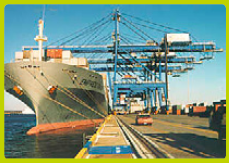Maryland Department of Transportation Conducts Peer-to-Peer Exchange on Freight Performance Measures
For More Information: https://ops.fhwa.dot.gov/freight/index.cfm
Contact Information: FreightFeedback@dot.gov

Federal Highway Administration
U.S. Department of Transportation
FHWA-HOP-12-042
View printable PDF
[258KB]
PDF files can be viewed with the Acrobat® Reader®.
Background
MDOT's Experience
Key Barrier To Support Performance Measures:
Determining what and how much data to collect.
Key Peer Exchange Finding:
Much of the required data was already collected.
Key Outcome:
Partnership formed to manage the freight performance measures program.
The main objective of the peer exchange was to identify and discuss issues and needs surrounding performance management systems for freight at MDOT. To accomplish this objective, the following action items were developed during the peer exchange:
- Confirm significant freight corridors/network.
- Coordinate with stakeholder organizations to obtain more in-depth freight reliability related insights.
- Make a commitment to defining data needs and performance measures.
- Establish a process to allow for a flexible and sustainable freight performance measurement system.
- Lay a foundation for ongoing, sustained outreach and education around Maryland's freight network, its contributions, and needs.

The Peer Exchange provided MDOT with the opportunity of overcoming the immediate hurdle of getting all of the modal stakeholders together.
CONTACT:
Debbie Bowden
Freight and Economic Policy Analyst
Office of Freight and Multimodalism
Maryland Department of Transportation
410-865-1094 (phone)
410-865-1201 (fax)
dbowden1@mdot.state.md.us
Office of Freight Management and Operations
Federal Highway Administration
202-366-0408 (phone)
freightfeedback@dot.gov
On the web:
If you are interested in requesting a Freight Peer Exchange for your agency,
visit https://ops.fhwa.dot.gov/freight/fpd/
p2p/index.htm
for complete information.

Maryland's Statewide Freight Plan provides a comprehensifont-size: 12px;ve picture of goods movement in the state, establishes the importance of freight for economic growth and development, and provides a foundation for a multimodal, integrated set of policies and plans for the State's freight system. To monitor the effectiveness of various strategies and adjust strategic decisions based on results, the Maryland Department of Transportation (MDOT) and Office of Freight and Multimodalism (OFM) were interested in developing freight performance measures.

Through the assistance of the Federal Highway Administration's (FHWA) Office of Freight Management and Operations, a peer exchange was conducted in Baltimore January 12-13, 2011. Attendees included members of the MDOT Freight Intermodal Advisory Committee (including member organizations: State Highway Administration, Maryland Port Administration, and Maryland Transportation Administration) and plan implementation work groups. Peers from the Washington State Department of Transportation (WSDOT), the Minnesota Department of Transportation (Mn- DOT), the Texas Transportation Institute (TTI), and the Missouri Department of Transportation (MoDOT) also attended. In addition, representatives from FHWA provided technical assistance and guidance on data sources and performance measures monitoring.
Peer Exchange
The peer exchange began with peer TTI providing an overview of freight performance measures currently being used by various modes in both the United States and Canada. The visiting peers demonstrated that there are multiple methods to successfully address freight performance measures:
- MoDOT added freight specific goals to already existing goals and objectives.
- Both MnDOT and WSDOT developed new freight-specific goals and objectives.
Similarly, the three peers varied on the type and number of measures to monitor.
- MnDOT began collection with a number of measures and filtered the list down to only the most strategically important measures through an external annual scorecard and internal reports.
- MoDOT's department-wide tracker system successfully captures 21 freight related measures.
- WSDOT monitors performance by analyzing GPS data purchased from GPS vendors on pre-selected sections of their freeway. This GPS data analysis provides truck travel reliability indicators.
Finally, each of the three peers differed in how they came to realize the importance of measuring freight performance:
- MnDOT realized the importance through their statewide freight plan.
- WSDOT due to their trucking association.
- MoDOT due to the large freight volumes on their transportation network.
This variation between successful practices illustrates that there is not one specific formula for success; success is dependent on needs and goals of each individual agency.
Peer Exchange Outcomes
The peer exchange identified commonly tracked performance measures across the three State peers, including: travel speeds, travel times, and freight volumes.
The collaborative work during the peer exchange to identify key performance measures helped to make the concept of freight performance measures manageable. Bringing different modes together focused attention on freight. Prior to the peer exchange, an idea of freight performance measures seemed an enormous task to each of the individual modes. Peer presentations and discussions allowed stakeholders to understand that many of the processes are already established and the freight measures could be extracted through these processes; new processes did not need to be developed. After understanding more about the freight performance measures, it was determined that the MDOT's Office of Freight and Multimodalism and Office of Planning and Capital Programming could partner to manage the freight performance measures program and process.
MDOT has made progress on a number of their action items since the peer exchange:
- MDOT has identified significant highway and rail freight corridors and used that information to begin development of system mapping to assists in identifying freight related project needs within the State.
- When developing specific freight-related projects, MDOT has engaged with various stakeholders to provide freight reliability insights.
- A process has been established to allow for a flexible and sustainable freight performance
measurement system and seven freight performance measures are being reported in
MDOT annual performance measure documents: the Annual Attainment Report on
Transportation System Performance, Implementing the Maryland Transportation Plan,
and Consolidated Transportation Program. The performance measures are as follows:
- Average truck turn-around time at marine terminal.
- Percentage of the Maryland highway network in overall preferred maintenance condition.
- Annual number and rate of traffic fatalities and personal injuries on all roads in Maryland.
- Number of bridges and percent that are structurally deficient.
- Percent of roadway miles with acceptable ride condition.
- Port of Baltimore foreign cargo and general cargo tonnage.
- Percent of freeway lane-miles and arterial lane-miles with average annual volumes at or above congested levels.